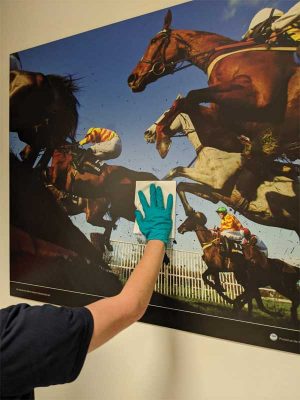
Laminated photography should be treated as if the laminate is PVC, with attention paid to the edges of graphics and the duration of exposure to the cleaning agent.
Take pre-emptive action with media
One can help keep graphics in good visual condition while retaining hygiene by choosing the correct printable media at the outset. As the industry has seen, floor graphics are particularly susceptible to damage, which may then in turn pose a serious trip hazard, so it is essential to use graphics materials and adhesives designed specifically for floor applications. Similarly, there are products developed for fast food and retail counters that feature a moisture barrier for hygiene and protection, while anti-graffiti films are especially designed to tolerate intense cleaning.
There are also products available that not only protect graphics and surfaces, but also actively inhibit the growth of bacteria and micro-organisms. Antimicrobial films are imbued with additives, incorporated during manufacturing to ensure distribution throughout the product, and have been shown to give long-term effectiveness even after regular cleaning with common disinfectants. They should also be resistant to general wear and tear, but a soft cloth should always be used to prevent serious abrasions; again, read the instructions before undertaking any cleaning.
These antimicrobial films can be used as a protective top layer for signs and graphics, but can also be applied to surfaces that are subjected to regular hand contact, such as counters, table-tops, door plates, and control panels. Antimicrobial films may be of particular use in environments such as hospitals, healthcare centres, schools, nurseries, stores, malls, restaurants,
and cafeterias.
Seek advice and stay safe
The spread of COVID-19 has prompted an unprecedented situation. It is essential for everyone, including signage businesses and their customers, to remember they are not alone and advice is available—just ask. Media manufacturers and suppliers, and those of cleaning solutions, will have the correct details and guidance on using their products effectively and safely. Brands, the trade press, and user communities are also doing a great job in sharing information on every issue affecting the industry, big and small.
Finally, it is better to be safe than sorry. No one wants to have to replace signage or display materials unnecessarily, but if a graphic is damaged or cannot be sanitized effectively, it is best to remove it completely and focus on making the surface underneath hygienic. And, while it may seem like the perfect time to spruce up a space, remember to take safety precautions when cleaning. Sign installers must protect themselves from both cleaning products and viruses to stay safe and healthy now and in the future.
With almost 10 years of experience with Drytac, David Morgan currently serves as technical assistance. With his excellent technical knowledge of chemistry and thorough understanding of the graphics market, Morgan offers sound advice on both products and applications. For more information, visit www.drytac.ca.





